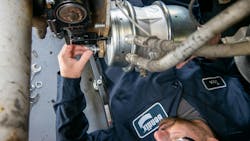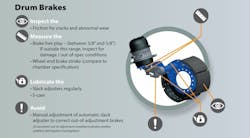Bendix Tech Tips: Avoiding CVSA inspection issues
Brake-related violations and tire issues once again accounted for more than half of all vehicle out-of-service violations during the 2024 Commercial Vehicle Safety Alliance (CVSA) International Roadcheck. These numbers underscore the ongoing importance of consistent preventive maintenance and thorough inspection routines. With the 2025 Roadcheck set for May 13-15, Bendix Commercial Vehicle Systems has collected updated insights and best practices to help drivers, technicians, and fleets better prepare for North America’s largest commercial vehicle inspection event.
“Brake performance starts with using the right friction,” Conklin said. “It’s critical to use components engineered to OEM specifications and to meet Reduced Stopping Distance (RSD) standards. That includes replacing brake pads or shoes in matched axle sets to maintain braking balance.”
Conklin added, “Mismatched or uncertified materials can reduce stopping power and negatively affect safety systems.”
Air disc brakes, with their internal automatic adjustment systems, continue to gain traction in the industry due to easier inspections and reduced risk of out-of-adjustment violations, along with their performance advantages.
Tire Systems and Tractor Protection Systems
Tire health is a Roadcheck 2025 area of focus. Vehicle inspection includes checks on tires for tread depth, inflation, sidewall integrity, and proper repair. Tire failures on the road pose major safety risks, and proactive maintenance can help avoid costly roadside emergencies.
More than 20% of vehicle violations during the 2024 Roadcheck were related to tires. Underinflation remains a leading cause of tire failure, contributing to blowouts, accelerated wear, and reduced fuel efficiency.
“Underinflated tires are more than a wear issue – they’re a potential safety liability, increasing the chance of sudden failure due to excessive heat buildup,” said Brian Screeton, manager – technical training and service at Bendix. “With today’s technology, there’s no reason not to monitor pressure in real time and catch problems before they turn into emergencies.”
To support tire health, Bendix recommends real-time tire pressure monitoring systems (TPMS), including the SmarTire® and Trailer-Link™ systems. These provide continuous in-cab monitoring of both tire pressure and temperature.
“TPMS solutions offer more than just inflation alerts,” Screeton said. “They can also identify brake drag, which can cause dangerous heat and pressure buildup at the wheel-end.”
Drivers and technicians should also:
- Check tread depth and ensure it meets legal minimums.
- Inspect sidewalls for cuts, bulges, or embedded objects.
- Verify dual tires are properly matched and inflated.
- Conduct regular rotation and alignment checks.
Although not a 2025 focus category, tractor protection systems (TPS) remain under scrutiny after more than 560 TPS violations were reported in 2024. These systems help trailer brakes activate if the trailer becomes disconnected from the tractor.
“A functioning TPS can mean the difference between a safe stop and a runaway trailer,” Screeton said. “Fortunately, confirming that the system works correctly is quick and straightforward.”
Here’s a simplified method for verifying TPS operation:
1. Start the engine and allow the air system to fully pressurize.
2. Shut off the engine and disconnect both glad hands from the trailer.
3. Push in the red trailer-supply valve on the dash.
4. Air should vent from the trailer-supply glad hand until the red valve automatically pops back out.
5. Press the brake pedal. No air should escape from the service glad hand – if it does, then the TPS isn’t sealing properly.
“If anything in that sequence doesn’t behave as expected, it’s time for a deeper inspection,” Screeton noted.
Contamination is another common culprit behind TPS issues. Dirt or debris in the glad hand connection can travel downstream to the trailer relay valve, affecting brake release or causing dragging.
“When glad hands are uncoupled, always cover them using dummy couplers,” Screeton said. “It’s a small step that helps prevent big problems.”
Resources for Building a Culture of Safety
While International Roadcheck places an annual spotlight on compliance, the most effective safety strategies are built on everyday practices. That includes equipping personnel with the right training and support tools.
“Many violations documented during Roadcheck can be avoided. But it requires that drivers and technicians know what to look for, understand system behavior, and stay informed about evolving best practices,” Thomas said.
Bendix offers a wide range of resources to help support these goals, including:
- Bendix Brake Training School: One of the industry’s longest-running hands-on training programs. Available in-person and virtually. See the 2025 schedule.
- Brake-School.com: A free online learning platform with over 100 self-paced courses covering braking, electronics, air management, and more.
- Knowledge-Dock.com: A library of expert videos, blogs, FAQs, Tech Tips, and white papers.
- Bendix YouTube Channel: Short, practical videos on product features, maintenance procedures, and system operation – designed to support technicians and fleets in the field.
- 1-800-AIR-BRAKE (1-800-247-2725): A technical support hotline staffed by seasoned professionals who offer diagnostics, service guidance, and training assistance.
“Whether you’re a new technician or a veteran fleet maintenance leader, we want to make it easy to access the information and tools needed to do the job safely and effectively,” Thomas said.
Inspections as an Everyday Mindset
CVSA’s International Roadcheck offers more than just a snapshot of the industry’s safety posture. The event’s true value lies in the way it reinforces the role of inspection, education, and accountability in shaping long-term habits.
“Roadcheck is more than a once-a-year challenge,” Thomas said. “It’s a chance to turn insight into action and reinforce habits that drive year-round safety. That’s the mindset we want to support across the industry.”


